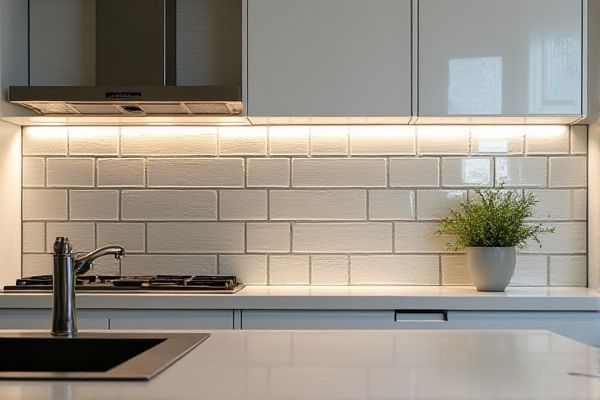
A full glass backsplash offers a sleek, modern look with easy cleaning and seamless installation, while traditional tile backsplashes provide a classic aesthetic with endless design possibilities and textured surfaces. Discover which option best suits Your kitchen style and maintenance preferences by reading the rest of the article.
Table of Comparison
| Feature | Full Glass Backsplash | Traditional Tile Backsplash |
|---|---|---|
| Material | Tempered glass sheet | Ceramic, porcelain, or natural stone tiles |
| Installation | Quick with adhesive; requires professional for glass cutting | Time-consuming; requires grout and precise tile placement |
| Maintenance | Easy to clean; non-porous surface resists stains | Needs regular grout cleaning; prone to mold and stains |
| Design & Appearance | Seamless, sleek, reflective finish | Varied styles, patterns, and textures |
| Durability | Highly durable; resistant to heat and moisture | Durable but grout may crack over time |
| Cost | Higher upfront cost due to material and installation | Generally lower cost; wide price range |
| Customization | Limited colors but customizable with back-painting | Extensive color and pattern options |
| Resale Value | Modern appeal can increase home value | Classic look preferred by traditional buyers |
Introduction to Kitchen Backsplashes
Full glass backsplashes offer a sleek, modern look with seamless surfaces that are easy to clean and highly resistant to stains and water damage. Traditional tile backsplashes provide a classic aesthetic with diverse patterns and textures, allowing for customizable design options but requiring more maintenance due to grout lines. Choosing between these options depends on your kitchen's style preferences and your desired balance between maintenance and visual impact.
What Is a Full Glass Backsplash?
A full glass backsplash is a single, continuous sheet of tempered glass installed on your kitchen or bathroom wall, offering a sleek, modern look with seamless surfaces that are easy to clean and maintain. Unlike traditional tile backsplashes composed of multiple grout-lined pieces, glass backsplashes provide a smooth, reflective finish that resists stains, mold, and water damage more effectively. This innovation in backsplash design enhances both the aesthetic appeal and functionality of your space while simplifying upkeep.
Traditional Tile Backsplash: An Overview
Traditional tile backsplashes offer a classic, versatile design with a wide range of colors, patterns, and textures to complement any kitchen style. They provide durable protection against moisture and stains, making maintenance straightforward through routine cleaning and occasional grout sealing. Your choice of tile material--ceramic, porcelain, or natural stone--directly impacts the backsplash's longevity, cost, and aesthetic appeal.
Aesthetic Appeal: Glass vs. Tile
Full glass backsplashes offer a sleek, modern aesthetic with a smooth, reflective surface that easily enhances kitchen lighting and creates a sense of spaciousness. Traditional tile backsplashes provide a textured, versatile look with endless design patterns, colors, and finishes, allowing for a personalized, classic style. Your choice impacts the kitchen's overall visual appeal, balancing contemporary minimalism against customizable warmth.
Durability and Maintenance Comparison
Full glass backsplashes offer superior durability with their non-porous surface, making them highly resistant to stains, mold, and moisture compared to traditional tile backsplashes that have grout lines prone to discoloration and cracking. Maintenance for glass backsplashes is easier and faster since they can be cleaned with a simple wipe of glass cleaner, while tile backsplashes require regular scrubbing and grout sealing to prevent damage. Choosing a full glass backsplash ensures your kitchen stays looking sleek and pristine with minimal upkeep over time.
Installation Process: Glass vs. Tile
Full glass backsplash installation involves precisely measured, single-pane panels that require professional cutting and secure mounting with adhesive or silicone for a seamless, glossy finish. Traditional tile backsplash installation consists of positioning individual ceramic or porcelain tiles with mortar or adhesive, followed by grouting to fill gaps, which demands more time and effort for alignment and finishing. Glass backsplashes offer quicker cleaning and fewer grout lines, while tile installations provide more customization in patterns but require ongoing grout maintenance.
Cost Differences Between Glass and Tile Backsplashes
Full glass backsplashes generally have a higher upfront cost compared to traditional tile backsplashes due to the expense of tempered glass and professional installation requirements. Tile backsplashes offer a more budget-friendly option with a wide range of materials and patterns available, allowing for greater customization without significantly increasing costs. Your choice will impact both the initial investment and long-term durability, with glass providing easier maintenance but a steeper price point.
Customization and Design Flexibility
Full glass backsplashes offer superior customization and design flexibility compared to traditional tile backsplashes, allowing for seamless, large-scale imagery, vibrant color saturation, and smooth, uninterrupted surfaces that enhance modern kitchen aesthetics. They can be tailored with printed patterns, gradients, or textured finishes, providing endless creative options beyond the fixed dimensions and grout lines of ceramic or porcelain tiles. This adaptability makes glass backsplashes ideal for achieving sleek, contemporary designs and easy integration with backsplashes featuring integrated LED lighting or reflective properties.
Pros and Cons of Full Glass Backsplash
Full glass backsplashes offer a sleek, seamless surface that is easy to clean and resistant to stains, making them ideal for maintaining a hygienic kitchen environment. However, they can be more expensive and prone to visible fingerprints and scratches compared to traditional tile backsplashes, which offer more design variety and durability against impact. Your choice depends on whether you prioritize modern aesthetics and ease of maintenance over cost and design flexibility.
Pros and Cons of Traditional Tile Backsplash
Traditional tile backsplash offers versatile design options and durability, making it a popular choice for kitchens. However, grout lines can accumulate dirt and require regular cleaning, and tiles may chip or crack over time, impacting maintenance. Your decision should weigh the aesthetic appeal and texture variety against the potential upkeep and longevity challenges.
 homyna.com
homyna.com